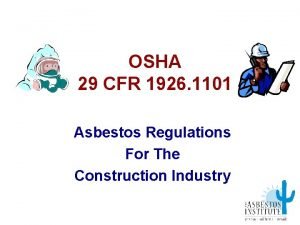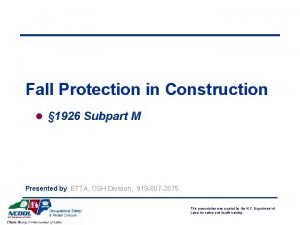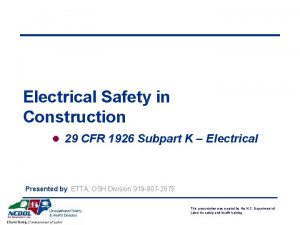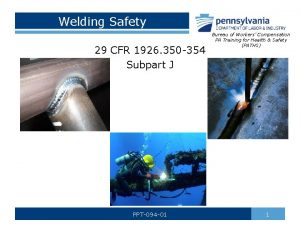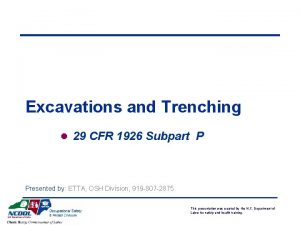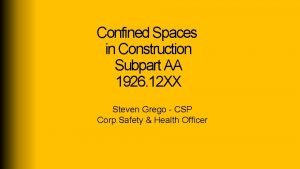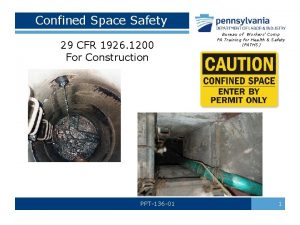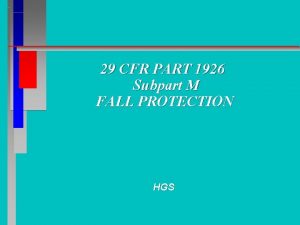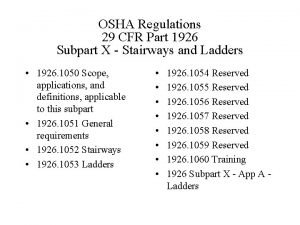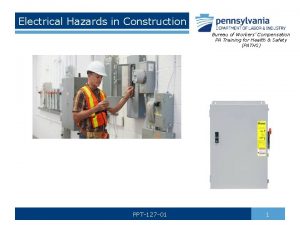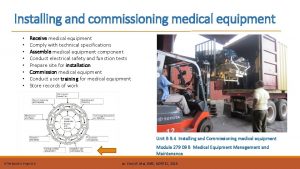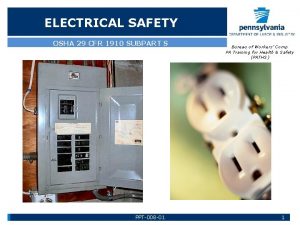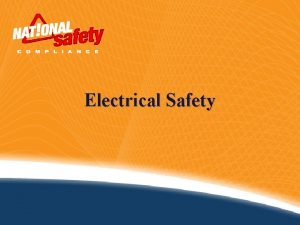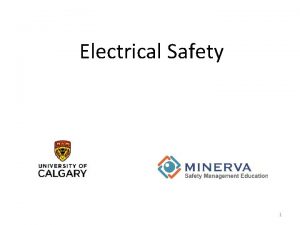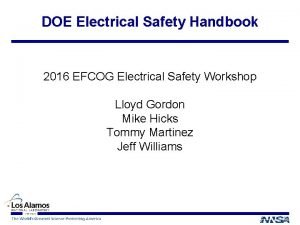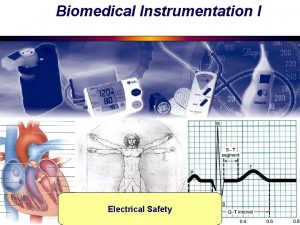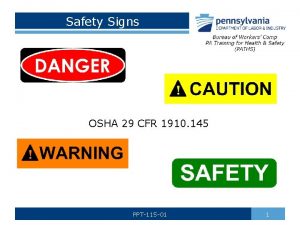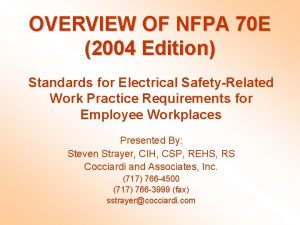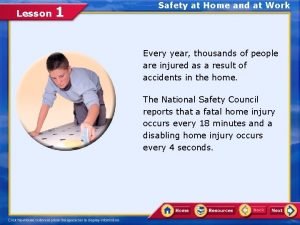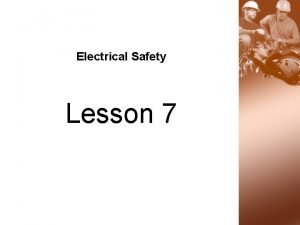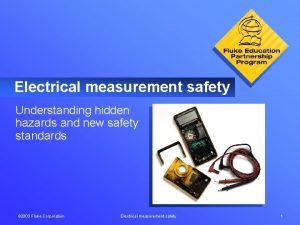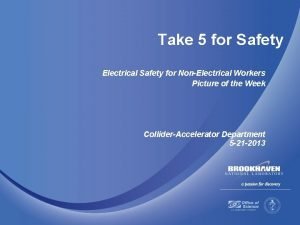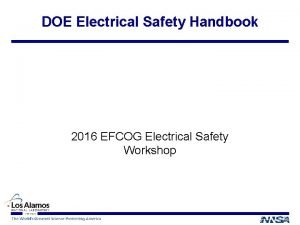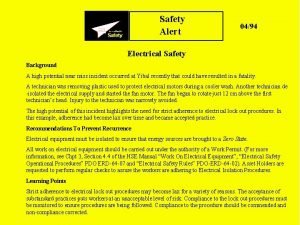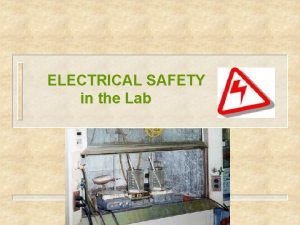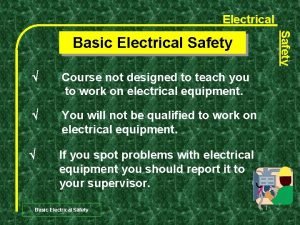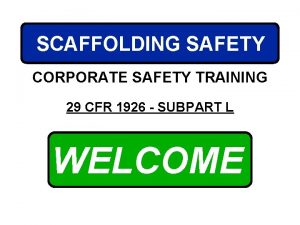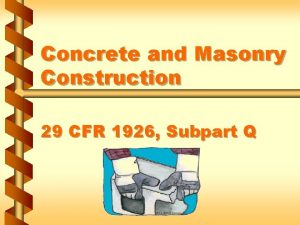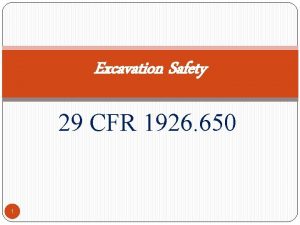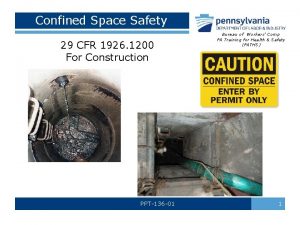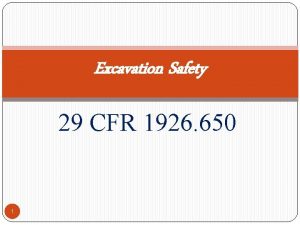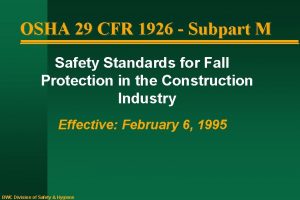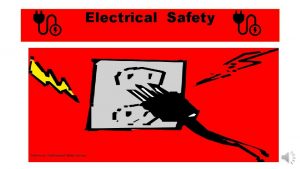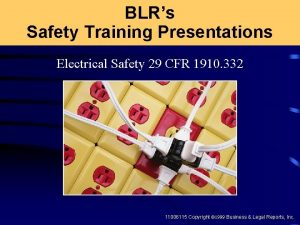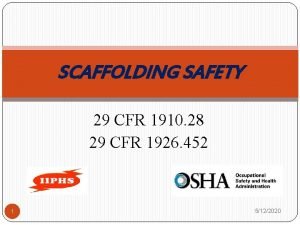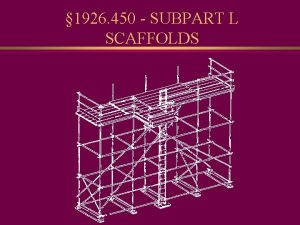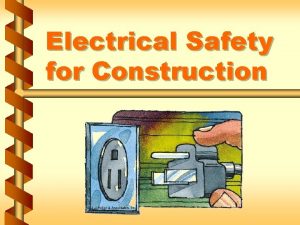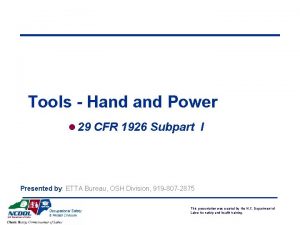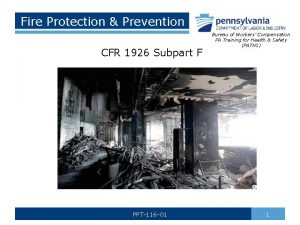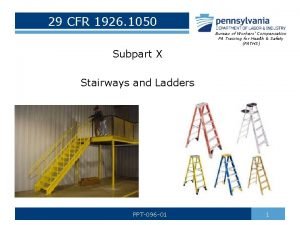Electrical Safety in Construction l 29 CFR 1926
































- Slides: 32

Electrical Safety in Construction l 29 CFR 1926 Subpart K – Electrical Presented by: ETTA, OSH Division 919 -807 -2875 This presentation was created by the N. C. Department of Labor for safety and health training.

Objectives In this course, we will discuss the following: l Common electrical hazards l Standards relating to those hazards l Electrical equipment defects/hazards l Tools/techniques used in identifying hazards This presentation was created by the N. C. Department of Labor for safety and health training.

29 CFR 1926 - Subpart K l 1926. 400 l 1926. 402 l 1926. 403 l 1926. 404 l 1926. 405 – Introduction – Applicability – General requirements – Wiring design and protection – Wiring methods, components, and equipment l 1926. 406 – Specific purpose equipment and installations l 1926. 407 – Hazardous (classified) locations l 1926. 408 – Special systems l 1926. 416, 417, 431, 432, 441 – Safety-related practices and maintenance l 1926. 449 – Definitions This presentation was created by the N. C. Department of Labor for safety and health training.

Common Electrical Hazards l Electric shock/electrocution occurs, when current flows through the body damaging the body l Electrical burns are caused by arc blast or hot conductors l Indirect falls from ladders, scaffolds or other walking and working surfaces This presentation was created by the N. C. Department of Labor for safety and health training.

Common Electrical Hazards l Explosions can occur due to electricity (ignition source) - Example » When the atmosphere contains flammable vapors l Electrical fires can be caused by overloading a circuit, appliance, faulty wiring, etc. This presentation was created by the N. C. Department of Labor for safety and health training.

General Requirements 1926. 403(b)(1) l Electrical equipment must be free from recognized hazards that can cause death or serious physical harm to employees - Suitability for installation - Mechanical strength and durability - Electrical insulation - Heating effects under condition of use - Arcing effects - Classification by type, size, voltage, current capacity, specific use NCDOL Photo Library This presentation was created by the N. C. Department of Labor for safety and health training.

General Requirements 1926. 403(b)(2) l Listed, labeled, or certified equipment must be installed and used in accordance with instructions included in the listing, labeling or certification NCDOL Photo Library This presentation was created by the N. C. Department of Labor for safety and health training.

l l l l Nationally Recognized Testing Laboratories Canadian Standards Association (CSA International) Communication Certification Laboratory, Inc. (CCL) Curtis-Straus LLC (CSL) FM Approvals LLC (FM) Intertek Testing Services NA, Inc. (ITSNA) MET Laboratories, Inc. (MET) NSF International (NSF) National Technical Systems, Inc. (NTS) SGS U. S. Testing Company, Inc. (SGSUS) Southwest Research Institute (SWRI) TUV SUD America, Inc. (TUVAM) TUV SUD Product Services Gmb. H (TUVPSG) TUV Rheinland of North America, Inc. (TUV) Underwriters laboratory Inc. (UL) Wyle Laboratories, Inc. (WL) This presentation was created by the N. C. Department of Labor for safety and health training.

Box Not Approved as a Pendant This presentation was created by the N. C. Department of Labor for safety and health training.

General Requirements 1926. 403(b)(2) l Equipment shall be installed and used in accordance with instructions NCDOL Photo Library This presentation was created by the N. C. Department of Labor for safety and health training.

Used in Accordance With Instructions NCDOL Photo Library This presentation was created by the N. C. Department of Labor for safety and health training.

General Requirements 1926. 403(h) l Each service, feeder, and branch circuit, at its disconnecting means or over current device, shall be legibly marked to indicate its purpose NCDOL Photo Library This presentation was created by the N. C. Department of Labor for safety and health training.

General Requirements 1926. 403(i)(2) l Live parts of electric equipment operating at 50 volts or more shall be guarded against accidental contact by cabinets or other forms of enclosures, or by another suitable method NCDOL Photo Library This presentation was created by the N. C. Department of Labor for safety and health training.

Wiring Design and Protection Correct Polarity l Polarity of connections - No grounded conductor may be attached to any terminal or lead so as to reverse designated polarity 1926. 404(a)(2) Hot Neutral Ground Hot NCDOL Photo Library Ground Neutral Reversed Polarity This presentation was created by the N. C. Department of Labor for safety and health training.

Wiring Design and Protection 1926. 404(b)(1)(i) l Employer shall use either ground fault circuit interrupters Or l An assured equipment grounding conductor program to protect employees NCDOL Photo Library This presentation was created by the N. C. Department of Labor for safety and health training.

Wiring Design and Protection 1926. 404(f)(3) l Portable generators need not be grounded if: - Supplies only equipment mounted on the generator and/or cord and plug equipment is plugged into receptacle mounted on the generator - Noncurrent-carrying metal parts of equipment and grounding conductor terminals of the receptacle are bonded to generator frame NCDOL Photo Library This presentation was created by the N. C. Department of Labor for safety and health training.

Wiring Design and Protection 1926. 404(f)(3) l Vehicle-mounted generators; vehicle frame may serve as system grounding if: - Frame of the generator is bonded to the vehicle frame and - Generator supplies only equipment located on the vehicle and/or equipment plugged into the generator and This presentation was created by the N. C. Department of Labor for safety and health training.

Wiring Design and Protection 1926. 404(f)(3) - Noncurrent-carrying metal parts of equipment and grounding conductor terminals of the receptacles are bonded to the generator frame, and - System complies with all other provisions of this section This presentation was created by the N. C. Department of Labor for safety and health training.

Wiring Design and Protection 1926. 404(f)(6) l Path to ground from circuits, equipment, enclosures must be permanent and continuous This presentation was created by the N. C. Department of Labor for safety and health training.

Wiring Design and Protection 1926. 404(f)(7)(iv) l Equipment connected by cord and plug - Noncurrent-carrying metal parts which may become energized must be grounded if: » In a hazardous location » Operated at over 150 V to ground • Except guarded motors and appliances permanently insulated from ground » Hand held motor-operated tools » Equipment used in wet and/or conductive locations » Portable hand lamps NCDOL Photo Library This presentation was created by the N. C. Department of Labor for safety and health training.

Wiring Design and Protection 1926. 405(a)(2)(ii)(I)-(J) l Flexible cords and cables must be protected from damage l Extension cord sets used with portable electric tools and appliances must be of three-wire type and must be designed for hard or extra-hard usage This presentation was created by the N. C. Department of Labor for safety and health training.

Wiring Design and Protection 1926. 405(b)(1) l Conductors entering boxes, cabinets, or fittings must be protected from abrasion This presentation was created by the N. C. Department of Labor for safety and health training.

Wiring Design and Protection 1926. 405(b)(1) l Unused openings in cabinets, boxes and fittings must be effectively closed NCDOL Photo Library This presentation was created by the N. C. Department of Labor for safety and health training.

Wiring Design and Protection 1926. 405(b)(2) l All pull boxes, junction boxes, and fittings must be provided with a cover l If metal covers are used, they must be grounded This presentation was created by the N. C. Department of Labor for safety and health training.

Wiring Design and Protection 1926. 405(g)(1)(i) l Flexible cords and cables must be suitable for conditions of use and location l Permitted uses of flexible cords and cables - Pendants and fixture wiring - Portable lamps and appliances - Elevators cables, cranes, and hoists - Stationary equipment to facilitate their frequent interchange - Appliances where the fastening means and mechanical connections are designed to permit removal for maintenance and repair This presentation was created by the N. C. Department of Labor for safety and health training.

Wiring Design and Protection 1926. 405(g)(1)(iii) l Prohibited uses of flexible cords and cables - As substitute for fixed wiring of structure - Run through holes in walls, ceilings or floors - Run through doors, windows or similar openings - Attached to building surfaces - Concealed behind building walls, ceilings, or floors NCDOL Photo Library This presentation was created by the N. C. Department of Labor for safety and health training.

Wiring Design and Protection 1926. 405(g)(2)(iv) l Flexible cords shall be connected to devices and fittings so that strain relief is provided - Will prevent pull from being directly transmitted to joints or terminal screws NCDOL Photo Library This presentation was created by the N. C. Department of Labor for safety and health training.

Safety-Related Work Practices 1926. 416(b)(2) l Working spaces, walkways, and similar locations shall be kept clear of cords so as not to create a hazard to employees NCDOL Photo Library This presentation was created by the N. C. Department of Labor for safety and health training.

Safety-Related Work Practices 1926. 416(e) l Extension cords shall not be stapled, hung from nails or suspended by wire l Worn or frayed electric cords must not be used This presentation was created by the N. C. Department of Labor for safety and health training.

Tools for Identifying Hazards l An electrical receptacle voltage tester with GFCI tester - Line voltage probes This presentation was created by the N. C. Department of Labor for safety and health training.

Summary In this course, we discussed the following: l Common electrical hazards l Standards relating to those hazards l Electrical equipment defects/hazards l Tools/techniques used in identifying hazards This presentation was created by the N. C. Department of Labor for safety and health training.

Thank You For Attending! Final Questions? This presentation was created by the N. C. Department of Labor for safety and health training.
 29cfr1926.1101
29cfr1926.1101 1926 fall protection
1926 fall protection Osha 1926 extension cords
Osha 1926 extension cords 29 cfr 1926
29 cfr 1926 29 cfr 1926 subpart p
29 cfr 1926 subpart p Aa1926
Aa1926 29 cfr 1926
29 cfr 1926 Safety nets must be drop tested
Safety nets must be drop tested Osha 1926 subpart c
Osha 1926 subpart c Osha guardrail requirements 1926
Osha guardrail requirements 1926 Basic safety orientation
Basic safety orientation Basic safety orientation
Basic safety orientation Electrical hazards in construction
Electrical hazards in construction Electrical safety analyzer
Electrical safety analyzer Cfr 1910 subpart s
Cfr 1910 subpart s Electrical safety introduction
Electrical safety introduction Electrical safety introduction
Electrical safety introduction Doe electrical safety handbook
Doe electrical safety handbook Microshock and macroshock
Microshock and macroshock What are the three elements of electricity
What are the three elements of electricity Electrical safety case study answers
Electrical safety case study answers Osha safety signs and symbols
Osha safety signs and symbols Nfpa 70e 2004 standard for electrical safety
Nfpa 70e 2004 standard for electrical safety Lesson 1 electrical safety culture
Lesson 1 electrical safety culture Lesson 7 electrical safety
Lesson 7 electrical safety Fluke electrical measurement safety test answers
Fluke electrical measurement safety test answers Lesson 1: electrical safety culture
Lesson 1: electrical safety culture Take 5 electrical safety
Take 5 electrical safety Doe electrical safety handbook
Doe electrical safety handbook Electrical safety alert
Electrical safety alert Electrical lab safety
Electrical lab safety Basic electrical safety course
Basic electrical safety course Electrical safety office ghaziabad
Electrical safety office ghaziabad
